Unit 6 Nature in words Developing ideas Reading 课件(共31张)外研版(2019)选择性必修 第三册
文档属性
| 名称 | Unit 6 Nature in words Developing ideas Reading 课件(共31张)外研版(2019)选择性必修 第三册 | 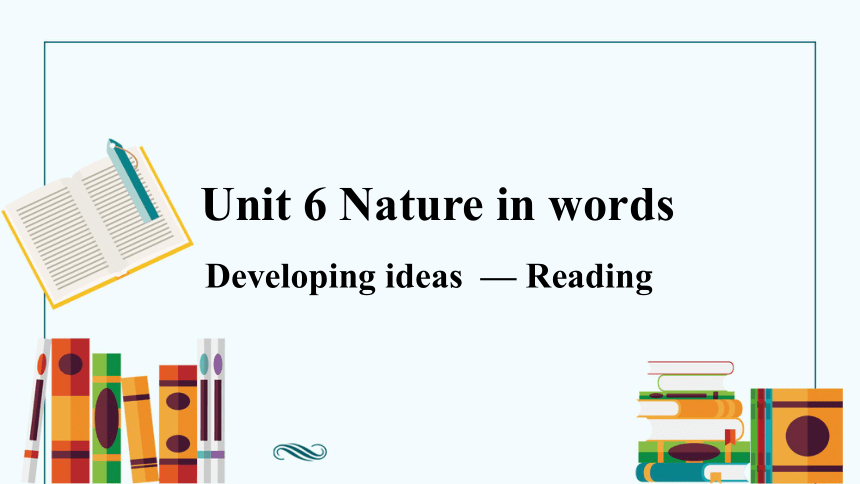 | |
| 格式 | pptx | ||
| 文件大小 | 1.6MB | ||
| 资源类型 | 教案 | ||
| 版本资源 | 外研版(2019) | ||
| 科目 | 英语 | ||
| 更新时间 | 2025-04-28 18:38:35 | ||
图片预览

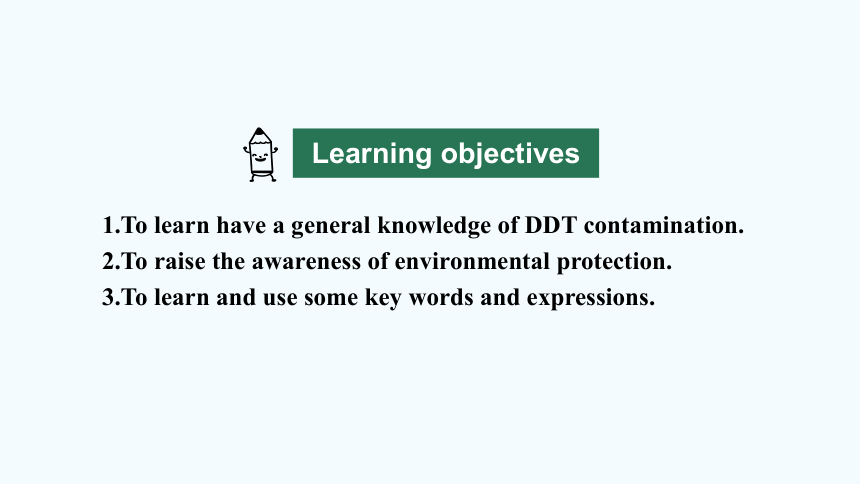
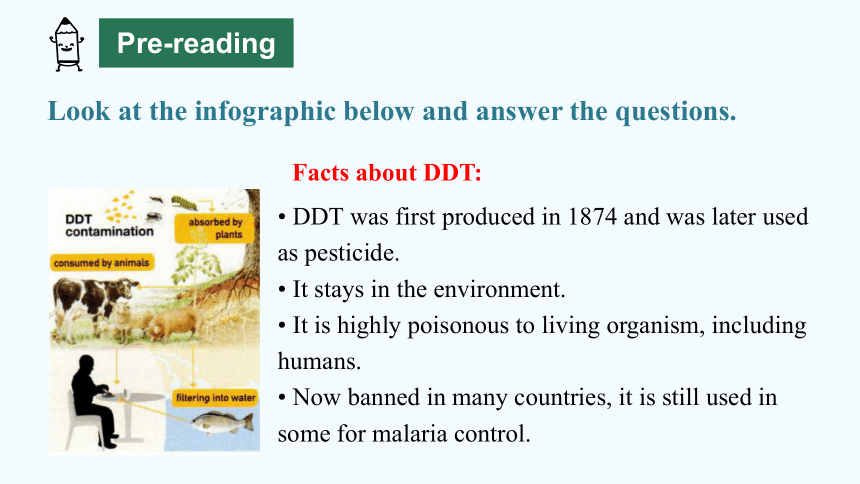
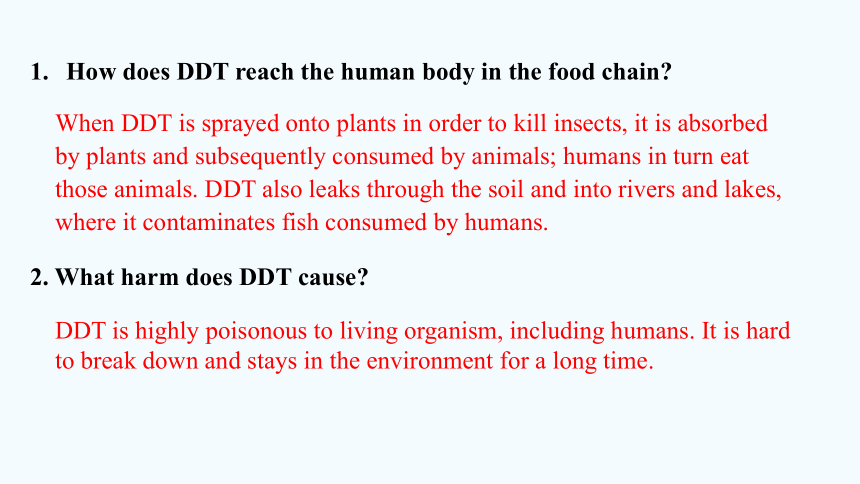
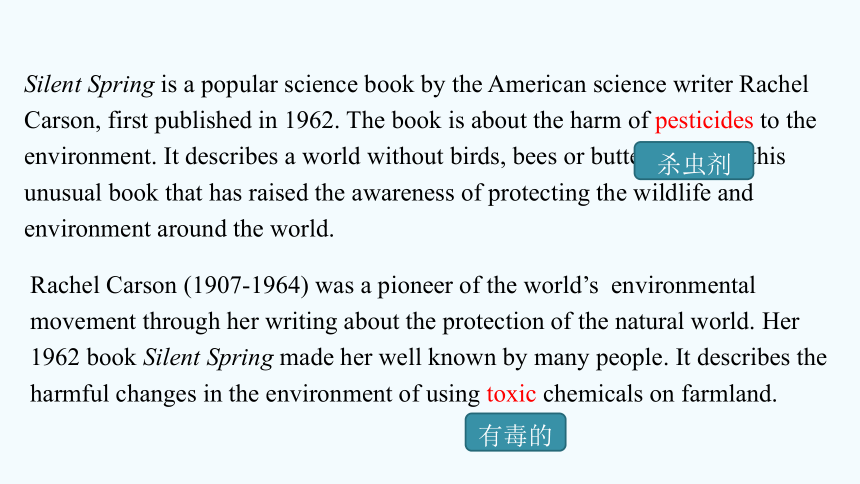


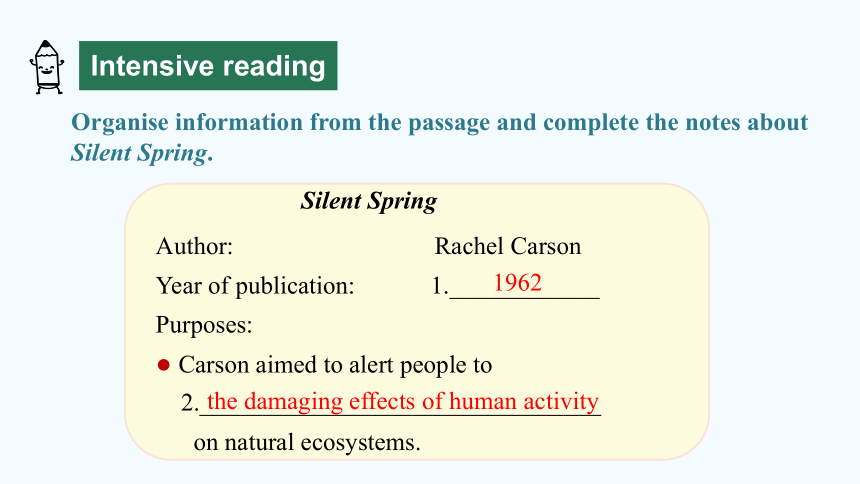
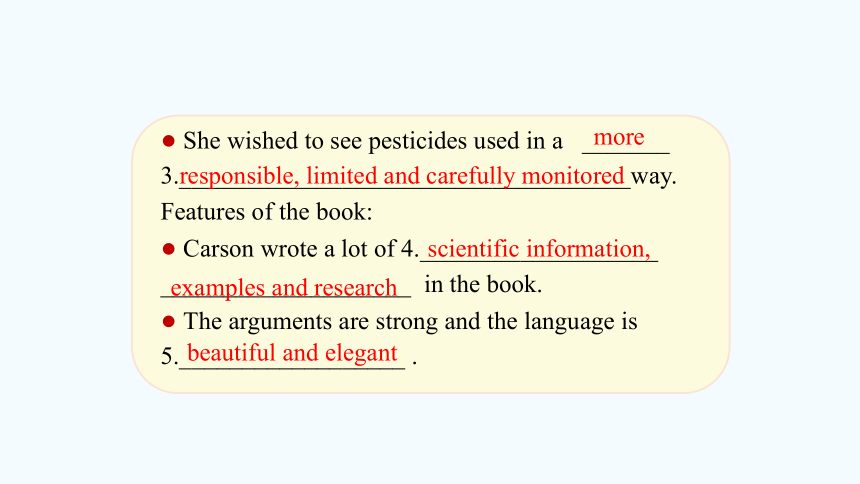

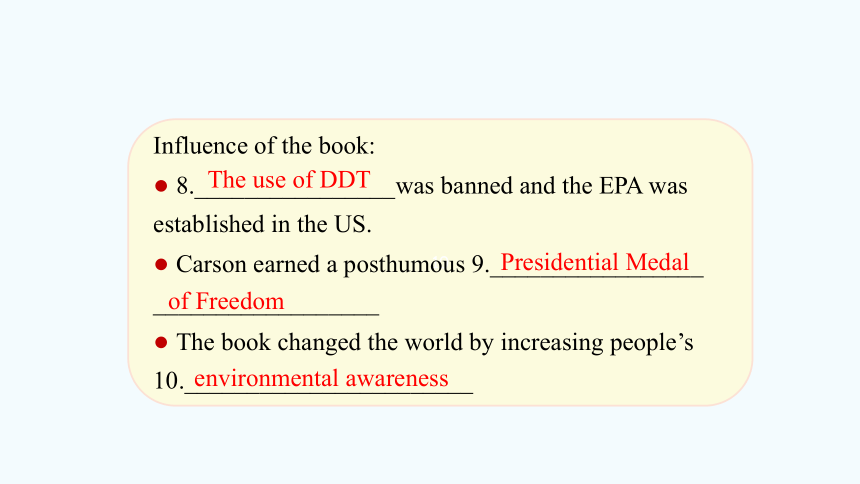
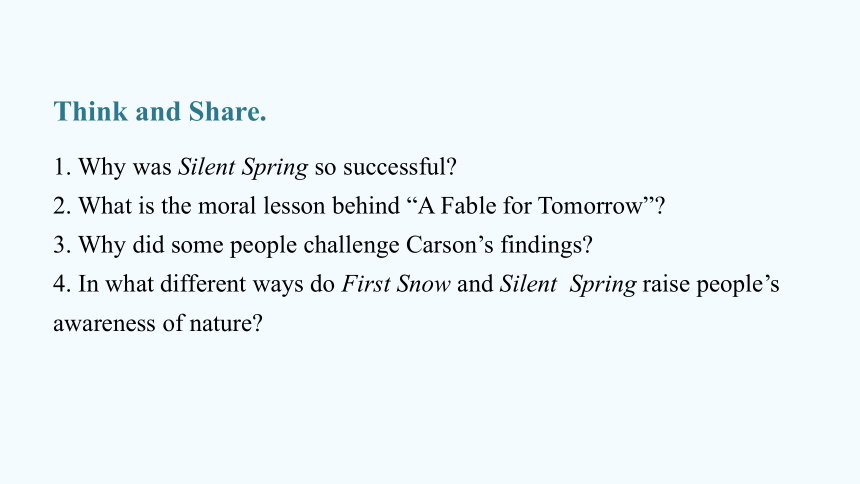
文档简介
(共33张PPT)
Developing ideas — Reading
Unit 6 Nature in words
1.To learn have a general knowledge of DDT contamination.
2.To raise the awareness of environmental protection.
3.To learn and use some key words and expressions.
Learning objectives
DDT was first produced in 1874 and was later used as pesticide.
It stays in the environment.
It is highly poisonous to living organism, including humans.
Now banned in many countries, it is still used in some for malaria control.
Look at the infographic below and answer the questions.
Facts about DDT:
Pre-reading
How does DDT reach the human body in the food chain
When DDT is sprayed onto plants in order to kill insects, it is absorbed by plants and subsequently consumed by animals; humans in turn eat those animals. DDT also leaks through the soil and into rivers and lakes, where it contaminates fish consumed by humans.
2. What harm does DDT cause
DDT is highly poisonous to living organism, including humans. It is hard to break down and stays in the environment for a long time.
Silent Spring is a popular science book by the American science writer Rachel Carson, first published in 1962. The book is about the harm of pesticides to the environment. It describes a world without birds, bees or butterflies. It is this unusual book that has raised the awareness of protecting the wildlife and environment around the world.
杀虫剂
Rachel Carson (1907-1964) was a pioneer of the world’s environmental movement through her writing about the protection of the natural world. Her 1962 book Silent Spring made her well known by many people. It describes the harmful changes in the environment of using toxic chemicals on farmland.
有毒的
Read the book review on Silent Spring, a book that led to the banning of DDT. Predict what will be mentioned in the passage.
It is a book review on Silent Spring, so the following parts may be mentioned in the passage:
1) basic information about the book, including the author, year of publication, theme and main idea;
2) the reason why this book is published;
3) features of the writing;
4) comments on this book;
5) influence of this book.
Fast reading
Read the passage and check your prediction.
basic information about the book, including the author, year of publication, theme and main idea;
2) the reason why this book is published;
3) features of the writing;
4) comments on this book;
5) influence of this book.
All the information is included.
Organise information from the passage and complete the notes about Silent Spring.
Intensive reading
Silent Spring
Author: Rachel Carson
Year of publication: 1.____________
Purposes:
● Carson aimed to alert people to
2.________________________________
on natural ecosystems.
1962
the damaging effects of human activity
● She wished to see pesticides used in a _______
3.____________________________________way.
Features of the book:
● Carson wrote a lot of 4.___________________
____________________ in the book.
● The arguments are strong and the language is 5.__________________ .
scientific information,
examples and research
beautiful and elegant
more
responsible, limited and carefully monitored
Opposing voices:
6.___________________said that Carson’s research is not precise.
Carson appeared in public and on television to 7.________________.
The pesticide industry
defend her claims
10
Influence of the book:
● 8.________________was banned and the EPA was established in the US.
● Carson earned a posthumous 9._________________
__________________
● The book changed the world by increasing people’s 10._______________________
The use of DDT
Presidential Medal
of Freedom
environmental awareness
Think and Share.
1. Why was Silent Spring so successful
2. What is the moral lesson behind “A Fable for Tomorrow”
3. Why did some people challenge Carson’s findings
4. In what different ways do First Snow and Silent Spring raise people’s awareness of nature
1. Why was Silent Spring so successful
Silent Spring was so successful because it alerted the general public to the dangers of DDT. It planted important new ideas in the public mind, such as that spraying chemicals to control insect populations has an impact on other wildlife, and that the chemicals got into the food chain.
2. What is the moral lesson behind “A Fable for Tomorrow”
The moral lesson is that financial profit should not come at the expense of the environment and the creatures living in it.
3. Why did some people challenge Carson’s findings
Some people challenged Carson’s findings because they were concerned about the negative impact they would have on business in the pesticide industry.
4. In what different ways do First Snow and Silent Spring raise people’s awareness of nature
First Snow shows the beauty of nature — and in particular the snow — through its words and imagery, while Silent Spring describes an unnatural spring without the beauty of birdsong. They each raise people’s awareness of nature by highlighting the interplay between nature and human behavior.
Work in groups. Write an award speech for Rachel Carson.
1. Read the passage again and make notes about Rachel Carson’s contributions to environmental protection.
Post-reading
Consider the following:
her most influential work
what points she tried to make
difficulties she met with
her personal qualities
her most influential work
Silent Spring
what points she tried to make
She aimed to alert not only the scientific community but also the general public to the damaging effects of human activity on natural ecosystems — in particular, to the harmful use of pesticides, such as DDT.
difficulties she met with
Her book quickly became a target for critics in the pesticide industry; There were many attempts to damage Carson’s reputation and stop her work from influencing public policy.
her personal qualities
Precise; determined; passionate etc.
2. Rachel Carson received her Presidential Medal of Freedom posthumously in1980.
Read the excerpt from President Carter’s award speech and note the language features.
Never silent herself in the face of destructive trends,Rachel Carson fed a spring of awareness across America and beyond. Always concerned, always eloquent, she created a tide of environmental consciousness that has not ebbed.
雄辩的,有说服力的
衰退;减退
3. Write your own award speech of about 100 words and share it with the class.
1. alert
v. ① 向……报警;使警觉;使警惕;使戒备
Neighbors quickly alerted the emergency services.
邻居很快向紧急情况服务部门报了警。
② alert sb. to sth.: make sb. aware of sth. 使意识到;使认识到
They had been alerted to the possibility of further price rises. 他们已意识到价格可能继续上涨。
Language points
adj. ① 警觉的;警惕的;戒备的
Suddenly he found himself awake and fully alert.
突然他发觉自己醒了过来,而且高度警觉。
② 意识到;注意到
We must be alert to the possibility of danger.
我们必须认识到危险的可能性。
2. thorough adj.
① 彻底的;完全的;深入的;细致的
The police carried out a thorough investigation.
警方展开了全面的调查。
② 十足的;彻头彻尾的;完完全全的
Everything was in a thorough mess.
一切都是乱七八糟的。
近义词:complete adv. thoroughly
3. precise adj. 准确的;确切的;精确的;明确的
precise details / instructions / measurements
确切的细节;明确的指令;精确的尺寸
Can you give a more precise definition of the word
你能给这个词下个更确切的定义吗?
近义词:accurate
to be precise 确切地说;准确地说
The shelf is about a meter long — well, 98cm, to be precise.
架子长约一米。嗯,精确地说,是 98 厘米。
4. crucial adj. 至关重要的;关键性的
a crucial factor / issue / decision
关键性的因素 / 问题 / 决定
It is crucial that we get this right.
我们把这个问题弄明白是极其重要的。
Parents play a crucial role in preparing their child for school.
父母对孩子做好上学的准备起着至关重要的作用。
4. crucial adj. 至关重要的;关键性的
He wasn’t there at the crucial moment.
(= when he was needed most) .
紧要关头他却不在那里。
近义词:critical; essential
adv. crucially
Chewing properly is crucially important.
正确地咀嚼是至关重要的。
1. aim to do sth ____________________
2. alert … to … ____________________
3. in particular ____________________
4. urge sb. to do sth ____________________
5. make sb. aware of ____________________
6. in addition to ____________________
旨在做某事
使意识到;使认识到
尤其;特别
敦促某人做某事
使某人意识到
除……之外(还有)
注意本句中表示对比关系的单词 once 和 now,通过对比过去春天生机盎然的早晨和现在春天万籁俱寂的早晨这两种不同的景象,感知本应该属于春天的美好事物(the dawn chorus of robins, catbirds, doves, jays, wrens, and scores of other bird voices)的消失,体会现在的春天没有一点儿声音的凄凉和恐怖,感悟 Silent Spring 的主题意义。
1. On the mornings that had once throbbed with the dawn chorus of robins, catbirds, doves, jays, wrens, and scores of other bird voices there was now no sound; only silence lay over the fields and woods and marsh.
2. The 50 or so pages at the end of the book list Carson’s sources, showing how thorough and precise she was as a scientist.
how 引导宾语从句,作为程度副词修饰 thorough 和 precise,表明了 Carson 作为科学家所具有的深入、严谨的品质。
showing 在本句中作伴随状语修饰前半句。
Honesty is regarded as the traditional virtue of our Chinese nation.
诚信被认为是我们中华民族的传统美德。
regard … as … 是固定搭配,意为“将……认为……”
3. Silent Spring was therefore regarded as a milestone in the launch of the green movement in the Western world.
4. Carson appeared in public and on television to defend her claims — and today, more than 50 years after it was published, the voice of Silent Spring is still ringing loud and clear.
本句中的 more than 50 years after it was published 是插入语,修饰 today, 说明书的影响和警示作用很深远,一直持续到该书出版五十多年后的今天。
loud and clear 意为“容易理解,清楚明白”
The message came through loud and clear.
那消息传达得清清楚楚。
5. This is not so much because of the quality of her arguments, strong though they are, but because of the beauty and elegance of her writing.
This 指代的是 She made a crucial but potentially difficult-to-understand subject interesting and accessible to millions of people.
the beauty and elegance of her writing 是这本书有趣、易读的主要原因。
本句的主体结构是 This is not so much because of ... but because of ...
5. This is not so much because of the quality of her arguments, strong though they are, but because of the beauty and elegance of her writing.
句中的 though 引导让步状语从句,从句在这里作插入语修饰 her arguments, 表明虽然书中的论据并不是它有趣、易懂的原因,但这些论据也是强有力的。
though 引导让步状语从句时,为了语气或正式文体的需要,通常可以改为倒装句式。
Young though he was, he knew how to behave well.
虽然他很年轻,但他知道如何举止得体。
1. Search the Internet to read more about Rachel Carson and Silent Spring.
2. Write a review about what you read.
Homework
Developing ideas — Reading
Unit 6 Nature in words
1.To learn have a general knowledge of DDT contamination.
2.To raise the awareness of environmental protection.
3.To learn and use some key words and expressions.
Learning objectives
DDT was first produced in 1874 and was later used as pesticide.
It stays in the environment.
It is highly poisonous to living organism, including humans.
Now banned in many countries, it is still used in some for malaria control.
Look at the infographic below and answer the questions.
Facts about DDT:
Pre-reading
How does DDT reach the human body in the food chain
When DDT is sprayed onto plants in order to kill insects, it is absorbed by plants and subsequently consumed by animals; humans in turn eat those animals. DDT also leaks through the soil and into rivers and lakes, where it contaminates fish consumed by humans.
2. What harm does DDT cause
DDT is highly poisonous to living organism, including humans. It is hard to break down and stays in the environment for a long time.
Silent Spring is a popular science book by the American science writer Rachel Carson, first published in 1962. The book is about the harm of pesticides to the environment. It describes a world without birds, bees or butterflies. It is this unusual book that has raised the awareness of protecting the wildlife and environment around the world.
杀虫剂
Rachel Carson (1907-1964) was a pioneer of the world’s environmental movement through her writing about the protection of the natural world. Her 1962 book Silent Spring made her well known by many people. It describes the harmful changes in the environment of using toxic chemicals on farmland.
有毒的
Read the book review on Silent Spring, a book that led to the banning of DDT. Predict what will be mentioned in the passage.
It is a book review on Silent Spring, so the following parts may be mentioned in the passage:
1) basic information about the book, including the author, year of publication, theme and main idea;
2) the reason why this book is published;
3) features of the writing;
4) comments on this book;
5) influence of this book.
Fast reading
Read the passage and check your prediction.
basic information about the book, including the author, year of publication, theme and main idea;
2) the reason why this book is published;
3) features of the writing;
4) comments on this book;
5) influence of this book.
All the information is included.
Organise information from the passage and complete the notes about Silent Spring.
Intensive reading
Silent Spring
Author: Rachel Carson
Year of publication: 1.____________
Purposes:
● Carson aimed to alert people to
2.________________________________
on natural ecosystems.
1962
the damaging effects of human activity
● She wished to see pesticides used in a _______
3.____________________________________way.
Features of the book:
● Carson wrote a lot of 4.___________________
____________________ in the book.
● The arguments are strong and the language is 5.__________________ .
scientific information,
examples and research
beautiful and elegant
more
responsible, limited and carefully monitored
Opposing voices:
6.___________________said that Carson’s research is not precise.
Carson appeared in public and on television to 7.________________.
The pesticide industry
defend her claims
10
Influence of the book:
● 8.________________was banned and the EPA was established in the US.
● Carson earned a posthumous 9._________________
__________________
● The book changed the world by increasing people’s 10._______________________
The use of DDT
Presidential Medal
of Freedom
environmental awareness
Think and Share.
1. Why was Silent Spring so successful
2. What is the moral lesson behind “A Fable for Tomorrow”
3. Why did some people challenge Carson’s findings
4. In what different ways do First Snow and Silent Spring raise people’s awareness of nature
1. Why was Silent Spring so successful
Silent Spring was so successful because it alerted the general public to the dangers of DDT. It planted important new ideas in the public mind, such as that spraying chemicals to control insect populations has an impact on other wildlife, and that the chemicals got into the food chain.
2. What is the moral lesson behind “A Fable for Tomorrow”
The moral lesson is that financial profit should not come at the expense of the environment and the creatures living in it.
3. Why did some people challenge Carson’s findings
Some people challenged Carson’s findings because they were concerned about the negative impact they would have on business in the pesticide industry.
4. In what different ways do First Snow and Silent Spring raise people’s awareness of nature
First Snow shows the beauty of nature — and in particular the snow — through its words and imagery, while Silent Spring describes an unnatural spring without the beauty of birdsong. They each raise people’s awareness of nature by highlighting the interplay between nature and human behavior.
Work in groups. Write an award speech for Rachel Carson.
1. Read the passage again and make notes about Rachel Carson’s contributions to environmental protection.
Post-reading
Consider the following:
her most influential work
what points she tried to make
difficulties she met with
her personal qualities
her most influential work
Silent Spring
what points she tried to make
She aimed to alert not only the scientific community but also the general public to the damaging effects of human activity on natural ecosystems — in particular, to the harmful use of pesticides, such as DDT.
difficulties she met with
Her book quickly became a target for critics in the pesticide industry; There were many attempts to damage Carson’s reputation and stop her work from influencing public policy.
her personal qualities
Precise; determined; passionate etc.
2. Rachel Carson received her Presidential Medal of Freedom posthumously in1980.
Read the excerpt from President Carter’s award speech and note the language features.
Never silent herself in the face of destructive trends,Rachel Carson fed a spring of awareness across America and beyond. Always concerned, always eloquent, she created a tide of environmental consciousness that has not ebbed.
雄辩的,有说服力的
衰退;减退
3. Write your own award speech of about 100 words and share it with the class.
1. alert
v. ① 向……报警;使警觉;使警惕;使戒备
Neighbors quickly alerted the emergency services.
邻居很快向紧急情况服务部门报了警。
② alert sb. to sth.: make sb. aware of sth. 使意识到;使认识到
They had been alerted to the possibility of further price rises. 他们已意识到价格可能继续上涨。
Language points
adj. ① 警觉的;警惕的;戒备的
Suddenly he found himself awake and fully alert.
突然他发觉自己醒了过来,而且高度警觉。
② 意识到;注意到
We must be alert to the possibility of danger.
我们必须认识到危险的可能性。
2. thorough adj.
① 彻底的;完全的;深入的;细致的
The police carried out a thorough investigation.
警方展开了全面的调查。
② 十足的;彻头彻尾的;完完全全的
Everything was in a thorough mess.
一切都是乱七八糟的。
近义词:complete adv. thoroughly
3. precise adj. 准确的;确切的;精确的;明确的
precise details / instructions / measurements
确切的细节;明确的指令;精确的尺寸
Can you give a more precise definition of the word
你能给这个词下个更确切的定义吗?
近义词:accurate
to be precise 确切地说;准确地说
The shelf is about a meter long — well, 98cm, to be precise.
架子长约一米。嗯,精确地说,是 98 厘米。
4. crucial adj. 至关重要的;关键性的
a crucial factor / issue / decision
关键性的因素 / 问题 / 决定
It is crucial that we get this right.
我们把这个问题弄明白是极其重要的。
Parents play a crucial role in preparing their child for school.
父母对孩子做好上学的准备起着至关重要的作用。
4. crucial adj. 至关重要的;关键性的
He wasn’t there at the crucial moment.
(= when he was needed most) .
紧要关头他却不在那里。
近义词:critical; essential
adv. crucially
Chewing properly is crucially important.
正确地咀嚼是至关重要的。
1. aim to do sth ____________________
2. alert … to … ____________________
3. in particular ____________________
4. urge sb. to do sth ____________________
5. make sb. aware of ____________________
6. in addition to ____________________
旨在做某事
使意识到;使认识到
尤其;特别
敦促某人做某事
使某人意识到
除……之外(还有)
注意本句中表示对比关系的单词 once 和 now,通过对比过去春天生机盎然的早晨和现在春天万籁俱寂的早晨这两种不同的景象,感知本应该属于春天的美好事物(the dawn chorus of robins, catbirds, doves, jays, wrens, and scores of other bird voices)的消失,体会现在的春天没有一点儿声音的凄凉和恐怖,感悟 Silent Spring 的主题意义。
1. On the mornings that had once throbbed with the dawn chorus of robins, catbirds, doves, jays, wrens, and scores of other bird voices there was now no sound; only silence lay over the fields and woods and marsh.
2. The 50 or so pages at the end of the book list Carson’s sources, showing how thorough and precise she was as a scientist.
how 引导宾语从句,作为程度副词修饰 thorough 和 precise,表明了 Carson 作为科学家所具有的深入、严谨的品质。
showing 在本句中作伴随状语修饰前半句。
Honesty is regarded as the traditional virtue of our Chinese nation.
诚信被认为是我们中华民族的传统美德。
regard … as … 是固定搭配,意为“将……认为……”
3. Silent Spring was therefore regarded as a milestone in the launch of the green movement in the Western world.
4. Carson appeared in public and on television to defend her claims — and today, more than 50 years after it was published, the voice of Silent Spring is still ringing loud and clear.
本句中的 more than 50 years after it was published 是插入语,修饰 today, 说明书的影响和警示作用很深远,一直持续到该书出版五十多年后的今天。
loud and clear 意为“容易理解,清楚明白”
The message came through loud and clear.
那消息传达得清清楚楚。
5. This is not so much because of the quality of her arguments, strong though they are, but because of the beauty and elegance of her writing.
This 指代的是 She made a crucial but potentially difficult-to-understand subject interesting and accessible to millions of people.
the beauty and elegance of her writing 是这本书有趣、易读的主要原因。
本句的主体结构是 This is not so much because of ... but because of ...
5. This is not so much because of the quality of her arguments, strong though they are, but because of the beauty and elegance of her writing.
句中的 though 引导让步状语从句,从句在这里作插入语修饰 her arguments, 表明虽然书中的论据并不是它有趣、易懂的原因,但这些论据也是强有力的。
though 引导让步状语从句时,为了语气或正式文体的需要,通常可以改为倒装句式。
Young though he was, he knew how to behave well.
虽然他很年轻,但他知道如何举止得体。
1. Search the Internet to read more about Rachel Carson and Silent Spring.
2. Write a review about what you read.
Homework
